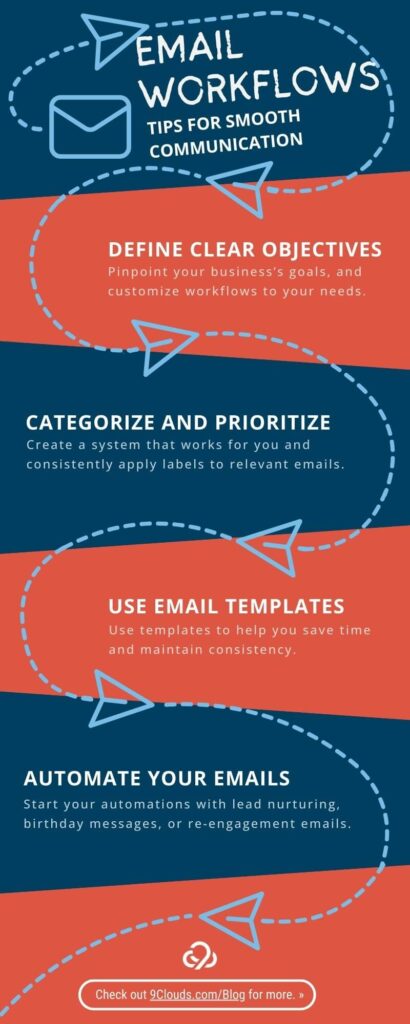
Email Workflows: Simple Tips for Smooth Communication
In the fast-paced world of modern communication, email remains a powerful tool for connecting with clients and colleagues alike. However, managing emails efficiently can be a daunting task, often leading to overwhelming inboxes and missed opportunities.
Enter email automation.
Automation — sometimes called a workflow when talking about email marketing — is all about saving time and keeping things organized, efficient, and running smoothly.
Maybe you send a specific sales email when a lead completes an action or fills out a form, or updates information about a contact when they take certain actions or click on certain pages on your site.
Automation not only saves you time but also reduces stress and boosts productivity.
Let’s explore the best practices for creating effective email workflows that will transform your inbox into a well-oiled communication machine (there’s an infographic at the bottom of this blog for our visual readers!).
Define Clear Objectives
Before diving into designing an email workflow, it’s crucial to identify your goals and objectives. Consider what you want to achieve with your email management strategy.
Do you want to improve response times, prioritize important messages, or reduce clutter? By defining clear objectives, you can tailor your email workflow to meet your specific needs.
Externally, automation gives us the power to send out email campaigns triggered by specific events (without waiting for a person to get to it). Internally, it’s a time-saver, freeing you from repetitive, mundane tasks so you can focus on the bigger picture for your business.
Categorize and Prioritize
A successful email workflow starts with organizing and prioritizing. Develop a system that works for you, and consistently apply these labels to relevant emails.
This practice will help you quickly identify which items to focus on, ensuring nothing falls through the cracks.
One of the most important parts of getting organized to begin your email automation process is collecting relevant information from your leads and customers.
Many workflows (which we’ll highlight below) are based on information collected from your contacts. They simply won’t work if you don’t have the right information to begin with.
Benefits of Automating Your Email Communication
- Collaborations between teams
- Personalized customer journeys
- Control over customer communications
- Enhanced brand awareness
- Greater sales conversations
- Improved productivity
- Optimum ROI for marketing efforts
- More real-time data for analysis
Leverage Email Templates
Using email templates can help you save time and maintain consistency. Think about the kinds of emails you send regularly — like follow-ups, customer reviews, or lead inquiries — and create reusable templates.
Start Automating Your Emails
Lead nurturing emails, personalized birthday messages (potentially with an offer included!), re-engagement emails to past customers, or emails to make sure people want to stay on your list are just a few ideas to get you started on your automation journey.
But first, you need to know the limitations of the tool you’re using. Every tool is different — and each will have different limitations. Here are some questions to ask yourself before getting things rolling:
- Are you using your email marketing tool as your CRM or importing customer data into it?
- Does your contact data match platform to platform?
- Does your email marketing tool have an automation feature built into it or is it an added cost?
- What are the limitations of your automation tool?
Take a Look Under the Hood
No matter what tool you use, you need to know both its strengths and its limitations.
For example, in Constant Contact, you can trigger a workflow to run based on actions like a person filling out a form or opening a specific email. (If your email marketing tool is all-inclusive and connected to your social media accounts and digital ad campaign manager, you can base it on those interactions as well.)
However, you can’t always base a workflow action on a general engagement such as “clicked on any email ever.”
If you’re importing your contacts into your email marketing tool, make sure to know if you can base actions on their import date or if it needs to be based on customer data such as a purchase date. Often, an automation can’t be triggered by a data import alone.
And if you are importing your data into another tool, it’s important to keep your data consistent across all platforms.
If a contact has unsubscribed in one tool, they should be unsubscribed in the other. Basically, if they have asked not to get emails from you, please don’t send them any.
Automation can send you an internal notification, letting you know if someone has unsubscribed, so you can manage the data in your other platforms accordingly.
Regularly Review and Improve Your Automations
Email workflows are not static. They should evolve with your changing needs.
Take time periodically to assess the success of your email workflow. Are there bottlenecks or areas for improvement? Does your welcome email include outdated content or information?
Don’t be afraid to embrace new tools, techniques, or email management software that can enhance your workflow and productivity.
Want Someone to Automate Your Emails for You?
Consider hiring a lead gen ally like 9 Clouds to help you with your email strategy.
When it comes to managing your email marketing, workflows can be a game-changer. Just remember, crafting the perfect email workflow is all about finding what works best for you.
We’re no strangers to the top email platforms and CRM email builders out there. And we know exactly how to make sure your message gets in front of the right people and drives some real results.
Win the Inbox With Email Marketing »






